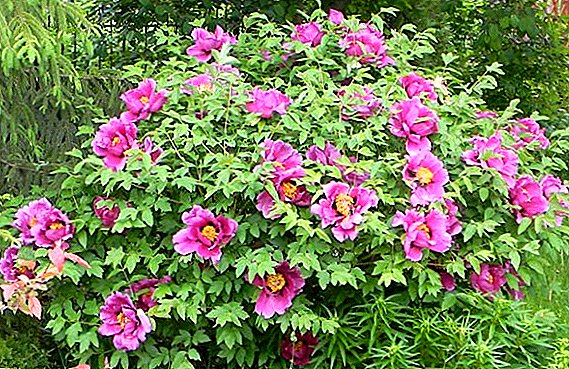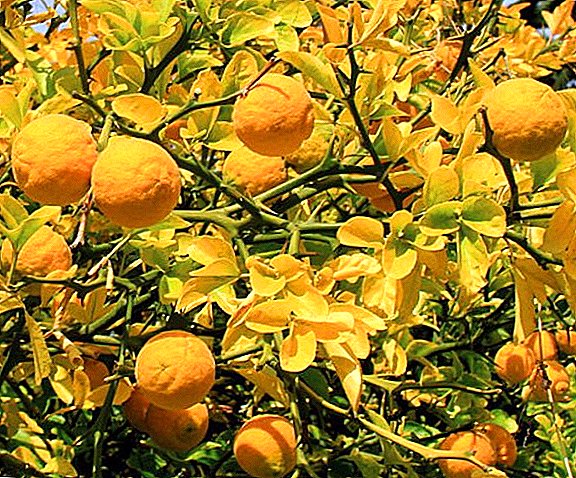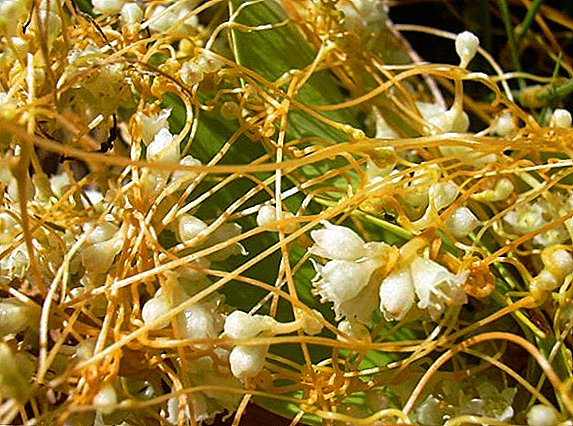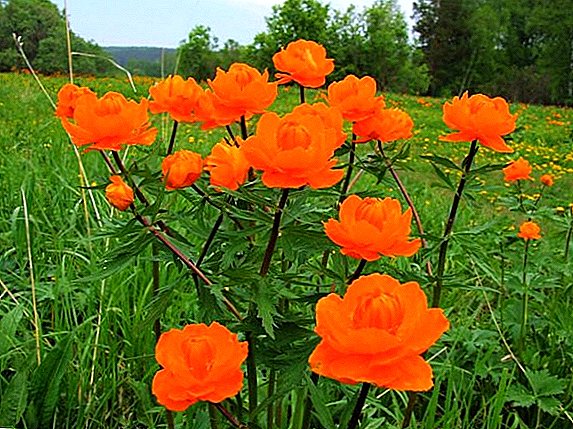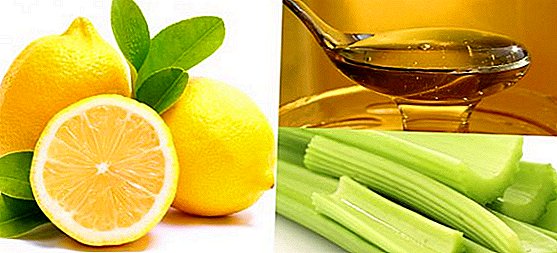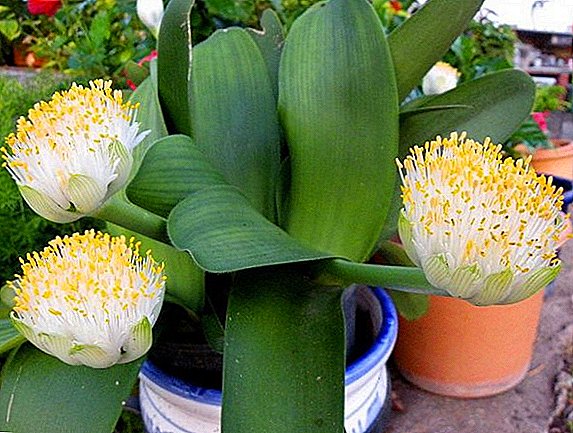 The white flowering hemanthus is popular with gardeners due to simple care and beautiful flowers. From the article you will learn about the features of this plant, its flowering, as well as how to grow a flower at home.
The white flowering hemanthus is popular with gardeners due to simple care and beautiful flowers. From the article you will learn about the features of this plant, its flowering, as well as how to grow a flower at home.
Botanical description and features
Evergreen perennial belonging to the Amaryllis family. Homeland and natural habitat - the tropics in South Africa. By type of root system refers to the onion. The stem is thick, reaches a height of 15-25 cm.
Did you know? Title "gemantus" originates from the Greek language and is formed as a result of two words "haemo" (blood) and "anthos" (flower).In the people the plant is called "elephant's tongue" or "deer ear". This is due to the elongated belt-like form of the leaves of the flower, which grow to a length of 40 cm. The leaves are dark green in color, dense and wide, with hairs at the edges. An adult Gemantus develops up to 6 sheets.
The inflorescence is dense, consists of a large number of stamens of white color with yellow anthers, the peduncle is thick and short. The fruits are red, round berries.
Rules of care and conditions of growing at home
Gemantus, like all houseplants, requires attention and the right conditions. About this further.
Choice of location
The optimal location for flower pots are windows to the east or west. You need to put a container with a "deer ear" in a sunny place, but avoid direct sunlight falling on it. You should also avoid drafts, and if necessary pritenyat plant.

Humidity and temperature
Hemanthus has good dry air tolerance. There will be no problems with the plant, even if it is in close proximity to sources of heating.
Although gemantus is from Africa, the optimal temperature for growing it is + 18 ... +22°C. But even a period of heat that does not last too long will not be a problem for a home plant.
Important! Hemantus leaves should be periodically cleaned from dust with a soft sponge dipped in warm water.
Lighting
These plants are sun-loving, lack of sufficient lighting will negatively affect their flowering. At the same time, hemantus should be protected from direct sunlight, which can leave burns on the foliage. Leaves affected by the sun cannot be recovered. They first lose their bright color, and then die off.
Soil and selection of planting pot
For gemantusa, you can purchase a special soil that is suitable for bulbous plants, but it is also easy to prepare it with your own hands: mix 2 parts of sod land, 1 part sand, peat and leaf soil. Before planting the soil mixture should be mixed and moistened.
Planting gemanthus is necessary in a wide and shallow pot, in which drainage holes must be present. A suitable width of a container for planting in diameter should be 2-3 cm larger than the diameter of the bulb. Pot material can be any: you can use a clay, ceramic or plastic pot.

Watering and fertilizer
The plant reacts negatively to waterlogging, and the lack of moisture causes wilting of the leaves. Water is watered with settled water at room temperature regularly, but the amount of water should be moderate: water should be watered when the soil layer dries at least 2 cm. With vegetative growth and during the flowering period, the white flowering hemantus needs fertilizers.
Feed the plant:
- fertilizer for bulbous;
- universal blends;
- organic dressings.
Fertilizers are applied once every three weeks. From top dressing should be abandoned from the moment of growth of the peduncle until they reach a height of 10 cm, and also after flowering before active spring growth begins.
Transplant and pruning
The deer ear needs a transplant every year. The procedure can be transferred for another year, if the roots have not grown enough, and there is a lot of free land in the flower container.
Important! It is not recommended to perform transplantation of the white-flowered hemantus less than once every 3 years.
Replace better in late February - early March. For the process using wide pots with a good layer of drainage. As with planting, they use either ready-mixed soil mixture, or mixed independently for transplantation.
Transplanting should be done carefully so as not to damage the bulb and roots. The bulb should be immersed in the ground for 2/3, part of it should remain on the surface. There is no need for pruning hemantus, you only need to remove dried leaves and flower stalks that have faded.
How does the Gemantus breed?
The reproduction of the white flowering hemantus is carried out by cuttings, seeds or with the help of daughter bulbs. Consider each of the methods in more detail.
With the help of daughter bulbs
The easiest method is used when transplanting an adult plant. 
For reproduction using daughter bulbs you need:
- Remove the parent gemantus from the container with the primer.
- Carefully separate the small bulbs.
- Plant bulbs in individual containers with soil.
- Before rooting the plant should be kept away from bright light.
With this method of reproduction, flowering can be expected 3-4 years after planting.
Leaf cuttings
Propagation by cuttings is more difficult.
For this you need:
- Separate one of the bottom sheets from the parent hemantus.
- Treat the cut point with crushed activated or charcoal in order to disinfect the cutting.
- Leave a sheet for a day so that it dries out.
- To plant a sheet in the moistened mix from equal parts of peat and sand and to cover with a polyethylene film.
- After the stalk forms an onion and is rooted, transplant it into a pot with the necessary soil for planting.
Gemantus after reproduction by cuttings blooms in 3-4 years.
Read also how to care for the money tree and propagate it.
Seeds
Propagation with the help of seeds is quite time consuming.
Technology:
- After acquiring red gemantas by fruits, collect seeds from it.
- After collecting the seeds, they are treated: they are washed in water and dried for 2-3 days.
- Prepare containers with a mixture of equal parts of peat, finely chopped bark and river sand.
- Sow the seeds into the mixture to a depth of 3-4 mm.
- Put the containers in a warm shaded place and cover with foil.
- Sprinkle the soil periodically.
- Expect germination, which can take 2-3 months.
- To plant the grown shoots.
When breeding seeds gemantus can bloom after 5-7 years.
Rest period and flowering features
The flower belongs to the evergreen, the characteristic period of rest is absent. Due to the reduced lighting and humidity in the room when growing indoors, it has a forced rest period, which lasts from October to February. During this period it is recommended to reduce watering and not fertilize the flower.

Gemantus blooms in late summer - early autumn, this period lasts 2-3 months. During flowering, it is sprayed with warm water and watered once every 3-6 days. With the release of pollen is characterized by the appearance of an unpleasant smell. The plant is self-pollinated, resulting in the ovary of round berries, the diameter of which is about 2 cm.
Possible cultivation difficulties
When growing "deer ear" problems may arise related to diseases and pests.
Did you know? Gemantus enriches the room with oxygen and ozone, and also contributes to the normalization of pressure in the inhabitants of the dwelling.
Diseases
The white flowering gemantus is disease resistant, but it can cause such diseases:
- Gray rot. The first sign is that the plant has small brown spots with a light gray patina. The spots gradually increase and become ashy gray in color, the leaves wither, and the flowering may be absent. Treatment: the plant is immediately isolated and treated with a fungicide. Yellowed and wilted parts of gemantus need to be removed, process the cut with activated carbon powder.
- Anthracnose. Symptoms: dark spots on the leaf plate and dark "smudges" at the edges. If the air is too dry, cracks appear on the affected parts of the plant. Without treatment, the flower may die completely. Treatment: remove diseased leaves and process "Fundazole."

In addition, the florist may encounter:
- lack of flowering - may be due to insufficient watering or too high temperature in the house in winter;
- bulb rotting - due to excess water during irrigation;
- gray on the leaves - due to hard watering;
- yellowing leaves - too much light.
Pests
Pests that more often affect white-flowered gemantus:
- Shchitovka. Insects of the horned family. With the defeat of the plant surface is covered with convex brown bumps, after the flower dries. The foliage is removed mechanically from the shield; it is impossible to remove pests from inflorescences. For deliverance, the plant is sprayed with "Aktellik" or "Karbofos".
- Amaryllis Worm. White insect that chooses a bulb onion as a habitat. A sign of the defeat of the flower is a lag in the growth and dropping of yellow leaves. It is necessary to carry out the treatment with insecticides and prevent over-wetting of the soil. If a pest is affected by a large part of the plant, it cannot be saved.
- Spider mite It feeds on plant cell contents. You can notice its appearance in the presence of small white dots on the leaf plate and a thin web that weaves the plant. It is necessary to remove pests mechanically and treat the plant with insecticides.
The birthplace of Gemantus white flowers - South Africa, but he won the sympathy of many flower growers outside. By following the tips and instructions regarding flower care, you can grow a beautiful home decoration.




